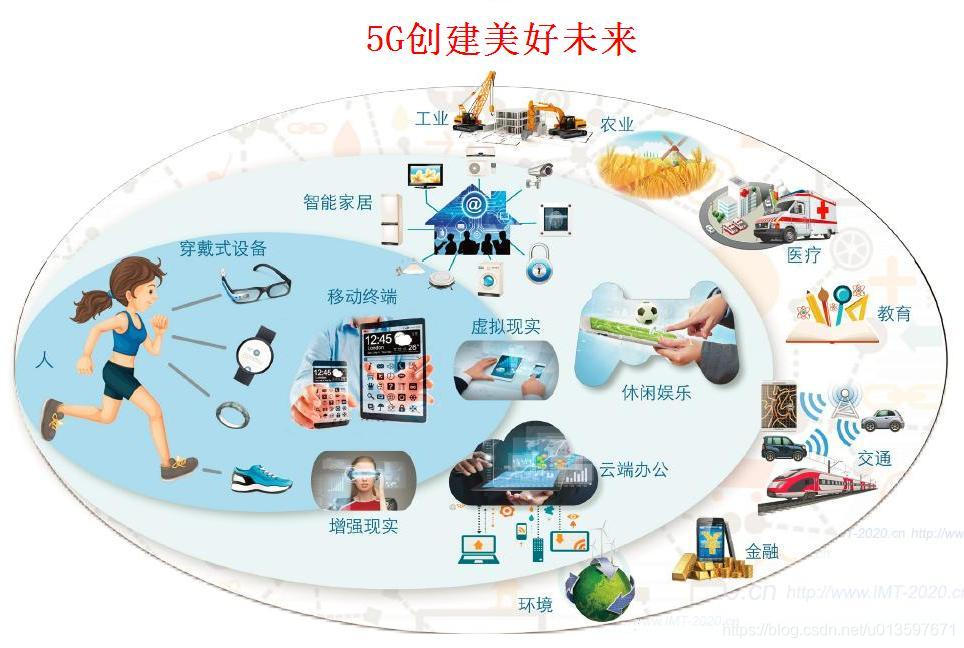本文经过多篇文章整理而成,参考 详解5G、5G 的应用场景及其性能需求
未来,5G将渗透到未来社会的各个领域,以用户为中心构建全方位的信息生态系统。


一、三个主要应用场景
- eMBB (enhanced Mobile BroadBand)
- mMTC(massive Machine Type Communications)
- URLLC(Ultra-Reliable and Low Latency Communications)
二、部署场景
2.1 高速率和高吞吐密度的场景 High datarates and traffic densities
-
市区宏覆盖场景Urbanmacro
-
郊区宏覆盖Ruralmacro
-
室内覆盖热点Indoorhotspot
-
拥塞场景下的宽带接入
Broadband accessin a crowd—用于异常高密度拥塞场景比如体育赛事,音乐会等.,在这个场景下的用户由于想和他们的朋友共享他们所看到听到的现场演出而产生的上行的资源需求远高于下行.
-
密集城区覆盖Denseurban
-
广播类业务覆盖Broadcast-likeservices
-
高速铁路覆盖High-speedtrain
-
高速路覆盖High-speedvehicle
-
飞机连接 Airplanes connectivity
这个场景用于为飞机内的乘客提供直接的或者机内的站点连接.
这些场景下的性能指标:

2.2 低延迟和高可靠性业务场景
整体的端到端的业务延迟 = 空中接口的延迟 + 5G系统内部传输和处理延迟 + 从5G出口到应用服务器延迟。因此降低延迟可以从两个方面考虑:
- 降低5G系统自身延迟
- 降低5G系统到应用服务器的延迟
如CDN的概念,将内容服务器部署到靠近运营商的地方,甚至部署到核心网中(或者核心网直接提供服务支持)。
需要低延迟和高可靠性的业务场景如下:
-
运动控制 Motioncontrol。
-
离散型自动处理系统 Discrete automation。
-
工序流程自动化系统 Process automation
Process automation 要求通信业务具有高可用性。支持 process automation业务的系统通常部署在限定的地理区域,通常只有授权的用户可以访问他们且通常服务于私有网络。
-
自动配电系统Automation for electricity distribution(mainly medium and high voltage).
自动配电系统要求通信业务的高可用性。作为社会基础设施,配电系统根植并深深浸透在公共区域,当然也是通过私有网络来提供业务。
-
智能运输系统 Intelligent transport systems – 基于街区交通流量的自动调度系统。
-
触觉交互系统 Tactile interaction
触觉交互系统定义为人类通过触觉和环境、人、或者控制的UE进行交互操作,这个操作依赖于触觉反馈。
-
远程控制Remote control 。

2.3 高精度定位 Higher-accuracy positioning
典型的应用区域就是汽车的免冲撞:每辆汽车都要知道自己的位置,附近其他汽车的位置以及他们可能的行进路线以避免发生碰撞。在工厂区域,定位诸如叉车,以及待组装的其他的配件等物品。
5G系统将通过3GPP和non-3GPP的技术来实现高精度定位。
相应的定位信息将通过适时,可靠和可用的方式获得。
UEs将能够共享位置信息。对于需要高精度定位信息的业务的需求如下:

三、性能相关的各项指标进行定义
-
峰值速率 Peak data rate
峰值速率是指在理想情况下的单UE的最高理论数据速率。下行峰值速率20Gbps,上行峰值速率10Gbps。Peakdata rate is the highest theoretical data rate which is the receiveddata bits assuming error-free conditions assignable to a single mobile station,when all assignable radio resources for the corresponding link direction areutilised (i.e., excluding radio resources that are used for physical layersynchronisation, reference signals or pilots, guard bands and guard times).
-
峰值频谱效率 Peak Spectral efficiency
最高频谱效率(Peak spectral efficiency)就是单位带宽传输频道上每秒可传输的最大比特数。目标下行峰值频谱效率是30bps/Hz,目标上行峰值频谱效率是15bps/Hz。Peak spectral efficiency is the highesttheoretical data rate (normalised by bandwidth), which is the received databits assuming error-free conditions assignable to a single mobile station, whenall assignable radio resources for the corresponding link direction areutilised (i.e., excluding radio resources that are used for physical layersynchronisation, reference signals or pilots, guard bands and guard times).
-
带宽 Bandwidth
Bandwidth means the maximal aggregated total system bandwidth. It may besupported by single or multiple RF carriers.
-
控制面延迟 Control plane latency
控制面延迟参考的时间区间是从IDLE状态到ACTIVE状态转换的时间。目标控制面延迟是10ms.对于卫星通信链路的控制面延迟要求比较特殊:GEO和HEO情况下为600ms (RTT),MEO情况下为180ms,而对于LEO的卫星系统则要求50ms。
Control plane latency refers to the timeto move from a battery efficient state (e.g., IDLE) to start of continuous datatransfer (e.g., ACTIVE).
-
用户面延迟 User plane latency
The time it takes to successfully deliver an application layerpacket/message from the radio protocol layer 2/3 SDU ingress point to the radioprotocol layer 2/3 SDU egress point via the radio interface in both uplink anddownlink directions, where neither device nor Base Station reception isrestricted by DRX.
对于URLLC, 目标上行和下行用户面延迟均是0.5ms .
对于eMBB, 目标上行和下行用户面延迟均是4ms。
对于卫星通信链路的控制面延迟要求比较特殊:GEO和HEO情况下为600ms (RTT),MEO情况下为180ms,而对于LEO的卫星系统则要求50ms。
-
不常见的小包延迟 Latency forinfrequent small packets
For infrequent application layer small packet/messagetransfer, the time it takes to successfully deliver an application layerpacket/message from the radio protocol layer 2/3 SDU ingress point at themobile device to the radio protocol layer 2/3 SDU egress point in the RAN, whenthe mobile device starts from its most “battery efficient” state.
对于20byte的上行包, 这个延迟应不差于10s .
-
移动中断时间 Mobility interruption time
Mobilityinterruption time means the shortest time duration supported by the system duringwhich a user terminal cannot exchange user plane packets with any base stationduring transitions.
目标移动中断时间是0ms,这个指标是针对5G系统内的同频和异频移动性制定的.
对于偏远乡村覆盖区来说,这个指标可以放宽松些.
-
系统间的移动性 Inter-system mobility
Inter-system mobility refers to theability to support mobility between the IMT-2020 system and at least one IMTsystem.
-
可靠性 Reliability
Reliabilitycan be evaluated by the success probability of transmitting X byteswithin a certain delay, which is the time it takes todeliver a small data packet from the radio protocol layer 2/3 SDU ingress pointto the radio protocol layer 2/3 SDU egress point of the radio interface, at acertain channel quality (e.g., coverage-edge).
通常的URLLC可靠性需求是1-10-5(as 99.999%, for 32 bytes with a user plane latency of 1ms)
对于eV2X业务,在用户面上传送300bytes的包的通信有效性和灵活性而言,需求如下:
- 可靠性Reliability = 1-10-5, 且用户面延迟 user plane latency = 3-10 msec, (for direct communication viasidelink and communication range of (e.g., a few meters))
- 可靠性Reliability = 1-10-5, 且用户面user plane latency = 3-10 msec,(the packet is relayed via BS.)
目标通信范围和可靠性需求依赖于部署和运作的场景和环境 ,比如汽车间的平均速度.